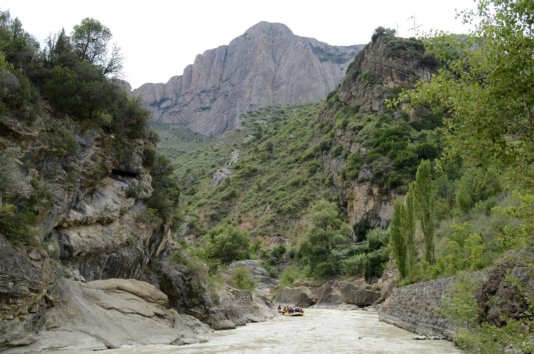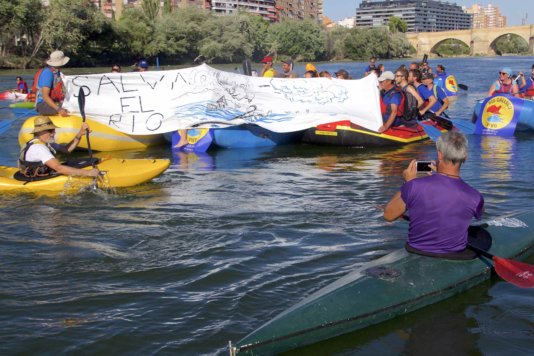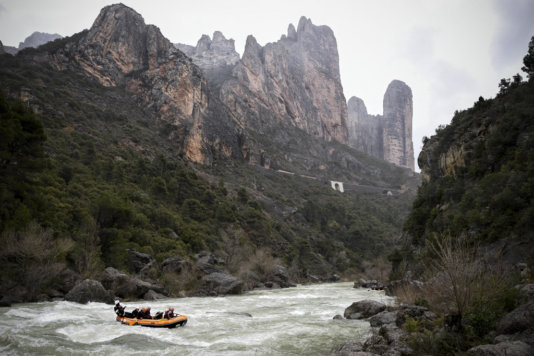- About
- Topics
- Picks
- Audio
- Story
- In-Depth
- Opinion
- News
- Donate
- Signup for our newsletterOur Editors' Best Picks.Send
Read, Debate: Engage.
| March 21, 2020 | |
|---|---|
| topic: | Conservation |
| tags: | #tourism, #Spain, #sustainabilty |
| located: | Spain |
| by: | Pablo Pérez Álvarez |
This way they have reversed the depopulation and ageing process they were enduring. However, they have been living for many years under the threat of a project to build a reservoir in the village of Biscarrués to divert water to another area’s farmland. If the dam materialises, it will put an end to their village’s main source of income.
Three decades ago, these villages were in a slow but inexorable decline. As in many other rural areas in Spain with deficient communications and scarce job opportunities, young people were emigrating to make a living and only senior citizens stayed in the village. Then, some people arrived from France and neighbouring region Navarre as they saw in its river section an ideal spot for rafting and other water sports such as canoeing.
The Gállego is one of the mightiest rivers born in the Pyrenees, but before it runs into the Ebro river its course is regulated by six dams. The reservoirs alter its flow almost entirely, except for two sections of 15 kilometres each. The one that runs through the Galliguera is one the only three spots in Spain suitable for the rough waters rafting, so some agencies began in the 1990s to offer this activity to tourists.
Rafting business grew and now there are ten agencies providing this service to visitors. They sell around 70,000 trips a year. This means 200 direct jobs in the area, 500 indirect jobs and annual revenues of 6 million Euros, according to the tourism sector.
This way the territory has revived and other young people – some of them, sons and daughters of those who had emigrated years before - have settled here. It also has fostered the set up of hotels, restaurants, camp grounds and rural tourism lodges.
Murillo de Gállego, the village where rafting agencies have their offices as it is in the middle of the rafting section of the river, has 180 inhabitants and 23 small-sized enterprises. But the rafting benefits get to the rest of Galliguera’s villages. In the whole area, the companies depending on the river add up to 80.
“This territory has raised up and proved that, respecting the environment and the river, a future inside this empty Spain is possible”, says Lola Giménez, spokesperson of a platform created by Galliguera neighbours and local councils to fight against the Biscarrués reservoir.
The dam project has rafting business in the Galliguera has been a sword of Damocles dangling over the rafting business since it began. It is part of a series of hydraulic works agreed to take water to irrigate crops in the Monegros, a semi-desert placed around 70 kilometres away.
The initial project, from 1987, was a 600 cubic hectometres reservoir and it was to flood a few Galliguera villages, but geological problems forced to reduce it to 192 hectometres first and to 35 later. In spite of that, the rafting providers claim that, if the dam is built, it will put an end to their business and, therefore, to the local economy.
“If they flood the lower section of the river, they will destroy 60% of the business, that is our territory development motor”, warns Giménez. “We depend directly on a section of the river that would be flooded by the reservoir, so our business model is in jeopardy”, agrees José María Sopeña, owner of a tourist services agency a local businessmen representative.
Sopeña arrived some years ago to Murillo to work in a restaurant. Over the years he got a rafting monitor title and ten years ago he created its own company. Now he lives in a village close to Murillo, Agüero, where his daughter was the first child to be born there in 17 years. Thanks to them and other families that moved to the zone because of the rafting, Ayerbe has been able to keep a primary school and a high school open.
Two years ago Spanish justice overturned the reservoir’s preliminary design and environmental impact statement because of the lack of studies and evaluations required by the EU Water Directive to allow the modification of water bodies with good status. But the biggest farmers association from Monegros has appealed to the Supreme Court asking that the public interest declaration of the construction shall prevail over the Water Directive. This way, new studies can be made to enable the built of the dam.
Galliguera’s population don’t understand why the development right of Monegros prevails to theirs. “You can not expect an area to grow at the expense of another one. It’s very unfair and undemocratic”, claims Giménez. “We don’t wish the ruin to anyone, but we want respect to our way of life and our decision to keep living in our territory”, she adds.
But the Biscarrués reservoir project raises many more objections. One of them has to do with climate change, which has caused a reduction in the volume of water carried by Pyrenees’ rivers, including the Gállego. This may make the dam pointless, alert many experts.
Pedro Arrojo, a university teacher specialised in the water’s economy and founder of the New Water Culture Foundation, underlines that according to the records of years 1993 to 2016 the river only exceed the required volume to start filling the reservoir 53 days, “that’s an average of 2.2 days a year”. What’s more, he adds, “15 of the 24 years the flow never reached that level, consequently the dam would have been completely useless”.
The ecologist movement rejects the building of the dam too, as they consider it as a method to manage the water outdated. “This kind of structure generally doesn’t belong to this century nor to the economic, demographic and climatological circumstances of these times”, points out José Luis Martínez, from the environmentalist organisation Ecologists in Action. “The reservoirs have been necessary at some point to regulate water. The problem is that they have turned rivers into waste pipes. A wrong and out-of-time view of this issue has led to turn the river, that is an ecosystem, into a pipe”.
But Monegro’s farmers, after three decades waiting for the Biscarrués reservoir, have taken this matter as something almost personal and they are not open to other alternatives. As they are an important economic group and represent an important bunch of votes compared with those from some little mountain villages, so far it hasn’t been easy for most of the political parties that have been ruling the country to rule out the project for good.
“This menace has blocked for so many years serious investments in the zone and has prevented the entrepreneurs to leap to invests in infrastructures”, remarks Sopeña. This small businessman compares the 70,000 users they serve every year to the 300.000 of the other zone in Spain offering a similar rafting experience.
This uncertainty is a burden not only on the companies, but also on the residents. Sara Pajares moved into Murillo de Gállego ten years ago. First, she worked in a bakery and later in a rafting agency. Now she earns a living with teleworking, but she wants to stay in the zone. Her sons (of 15, 18 and 19) wants to stay too. Although they are studying elsewhere, the three of them want to come back to make a living in the Galliguera in the tourist sector and with the adventure sports. “To me, the most important thing in a rural area is that when our children leave, they do it with the intention to return”, Sara explains. “This doesn’t happen in so many places, where people leave because there is nothing there and they think that they’ll never return because there is no job, nor leisure, nor life opportunities”.
However, she admits that she doesn’t dare buy a house in the village: “I dread to make the decision to investing in this territory for the long-term”. The possibility of a reservoir there “causes uncertainty to the families that have decided to stay here. We don’t want to buy a house and end up with an aberrant construction that may lead these villages to empty and lost his life compelling us to leave”.
By copying the embed code below, you agree to adhere to our republishing guidelines.



